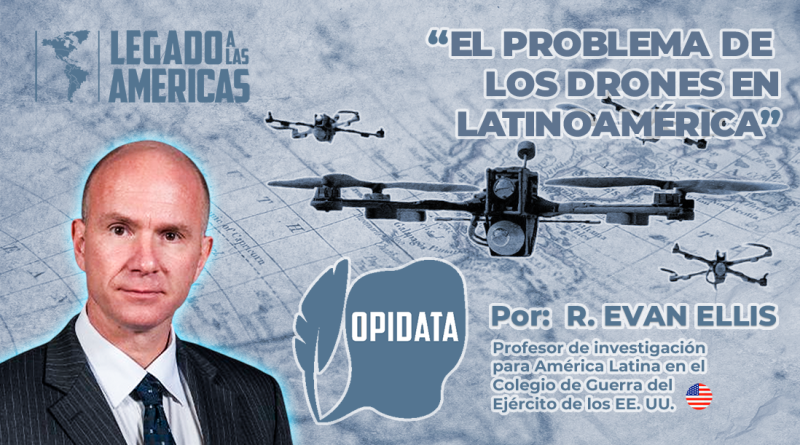
Latin America’s Drone Problem
Recent cases in Latin America
Latin America has a drone problem. In March 2025, a Colombian soldier in Catatumbo was killed in a strike by a weaponized unmanned aerial vehicle (UAV), launched by the National Liberation Army (ELN) terrorist group, in major combat operations that have killed more than 80 persons in the region and displaced at least 50,000. The month before, Mexican General Jorge Alejandro Gutiérrez was almost killed in a drone attack in Chihuahua, Mexico, when the convoy he was traveling in was attacked by a UAV targeting the specific vehicle he was traveling in. In September 2024, a drone carrying 40 pounds of explosives was sent against Ecuador’s maximum security prison La Roca near Guayaquil, significantly damaging the roof when it exploded, in an apparent attempt to break prisoners out of the facility. During the November 2024 Asia Pacific Economic Cooperation (APEC) leaders’ summit in Lima Peru, bringing together heads of state and other leaders from 21 states including China’s president Xi Jinping, Peruvian authorities neutralized 35 different potential drone threats.
From smuggling to war: drones in evolution
Even before Russia’s February 2022 invasion of Ukraine, unmanned aerial systems (UASes) and other advanced technologies were being employed by criminals, terrorists, and other non-state actors in Latin America in increasingly innovative and problematic ways. These this included the use of commercially available drones to conduct surveillance against authorities at sites such as border crossings, deliver cellphones into prisons, and fly crude explosives into targets. Between 2012 and 2014, the U.S. Drug Enforcement Agency (DEA) detected at least 150 drones carrying contraband, and conducting other activities along the U.S. border.
The war in Ukraine drove a sea change in drone warfare through battlefield innovation, showing the world (including criminal actors) what is possible, while at the same time, significantly expanding the drone market, from increasingly sophisticated commercial UAVs made by Chinese manufacturers like DJI, that could be easily adapted for military uses, to custom-built vehicles that could be assembled from components, to larger, more capable systems designed for military purposes, manufactured by states including Turkey, Iran, Russia, China, Israel, the European Union, and the United States, among others.
The institutional response and its limits
In Mexico, Michoacan and Guerrero have become hotspots for the use of drone warfare by the cartels, including the Jalisco Nuevo Generacion (CJNG) and the New Michoacan Family (LNFM) cartels, both designated by the U.S. government in February 2025 as terrorist organizations. Cartel attacks have reportedly featured increasingly quiet and sophisticated, explosive-laden drones, as well as vehicules with thermal cameras to detect humans. Colombian authorities interviewed for this work noted worrisome advanced tactics involving complimentary combinations of vehicles, including the mapping of targeted sites at night with thermal imaging sensors, to locate and facilitate attacks against concentrations of persons later.
As commercially-available drones become more advanced, the barrier of specialized knowledge for adapting commercial drones for military use in the region is also diminishing. Latin American security officials consulted for this work noted that the militarization of commercial drones is no longer specialized knowledge that can be limited or traced to a small group of individuals. Now virtually anyone with knowledge that can be acquired on the internet can purchase commercial drones with easily weaponizable capabilities, such as infrared sensors or the ability to drop payloads, and adapt them for military use.
Even before the takeoff of drone use by criminal and terrorist groups in Latin America, security forces and other government organizations in the region were developing their own drone capabilities, including drone detection and anti-drone technologies. At least 14 Latin American states currently possess and employ drones in their police and security forces, with Brazil having the biggest fleet, as well as a domestic drone industry. Still, the region’s response is limited by resources and cumbersome acquisition bureaucracies which struggle to keep up with the evolving challenge, among other impediments. Indeed, particularly beyond security forces, Latin American national and local governments cannot keep up with understanding how the evolving threats from drone surveillance, smuggling, strike and other operations make their operations, and the people and activities they support, vulnerable.
New threats: maritime and terrestrial drones
For Latin America, the current aerial vehicle challenge is only the tip of the iceberg in the evolving threat. Unmanned watercraft and submersible vehicles have long been available commercially. Custom-built unmanned watercraft have been employed in Ukraine as weapons, with devastating effects against Russian naval vessels. Similar vehicles could easily be used by Latin American criminal groups for smuggling contraband, terrorism or extortion against port infrastructure and commercial maritime vessels, including container ships, LNG tankers, or even cruise ships. In the same way, there are a wide array of unmanned ground systems, from self-driving cars, to robots that walk on two or more legs currently being developed by the Chinese, similarly be used for smuggling or terrorism. The current development of even unmanned underground vehicles may become available for such purposes in the region in the not-distant future.
Conclusion: are we prepared?
Latin America, as other parts of the world, is challenged by a broad variety of grave immediate problems. Still, the emerging challenge of unmanned systems in the hands of criminal, terrorist, and other threat groups is something that both the U.S. and governments of the region must take seriously, in anticipating risks and developing capabilities to mitigate or address the threat. As in other domains of hemispheric security cooperation between governments, including the U.S., has never been more important for the security of the region that we share.




Definitivamente el uso de vehículos terrestres, aéreos y marítimos no tripulados son en la actualidad un artificio de fácil adquisición y usó efectivo en contra de las autoridades qué luchan en contra de la delincuencia organizada pues son de fácil construcción, discretos en su usó y de gran letalidad, como se ha demostrado en diversas ocaciones en operativos en contra del narcotrafico, y le veo una dificultad para su control, pues se puede partir para su construcción de un juguete a control remoto y modificarlo, adaptandole a un verdadero transporte de explosivos o armamento letal en contra de las fuerzas de seguridad como ha ocurrido en México en diversas ocaciones provocando la baja de elementos y material con gran efectividad